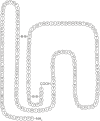Arterial pulse wave velocity, inflammatory markers, pathological GH and IGF states, cardiovascular and cerebrovascular disease
- PMID: 19337549
- PMCID: PMC2663454
- DOI: 10.2147/vhrm.s3220
Arterial pulse wave velocity, inflammatory markers, pathological GH and IGF states, cardiovascular and cerebrovascular disease
Abstract
Blood pressure (BP) measurements provide information regarding risk factors associated with cardiovascular disease, but only in a specific artery. Arterial stiffness (AS) can be determined by measurement of arterial pulse wave velocity (APWV). Separate from any role as a surrogate marker, AS is an important determinant of pulse pressure, left ventricular function and coronary artery perfusion pressure. Proximal elastic arteries and peripheral muscular arteries respond differently to aging and to medication. Endogenous human growth hormone (hGH), secreted by the anterior pituitary, peaks during early adulthood, declining at 14% per decade. Levels of insulin-like growth factor-I (IGF-I) are at their peak during late adolescence and decline throughout adulthood, mirror imaging GH. Arterial endothelial dysfunction, an accepted cause of increased APWV in GH deficiency (GHD) is reversed by recombinant human (rh) GH therapy, favorably influencing the risk for atherogenesis. APWV is a noninvasive method for measuring atherosclerotic and hypertensive vascular changes increases with age and atherosclerosis leading to increased systolic blood pressure and increased left ventricular hypertrophy. Aerobic exercise training increases arterial compliance and reduces systolic blood pressure. Whole body arterial compliance is lowered in strength-trained individuals. Homocysteine and C-reactive protein are two inflammatory markers directly linked with arterial endothelial dysfunction. Reviews of GH in the somatopause have not been favorable and side effects of treatment have marred its use except in classical GHD. Is it possible that we should be assessing the combined effects of therapy with rhGH and rhIGF-I? Only multiple intervention studies will provide the answer.
Keywords: arterial pulse; arterial stiffness; growth hormone; insulin-like growth factor; physiology; wave velocity.
Figures

Similar articles
-
Changes in endothelial dysfunction and associated cardiovascular disease morbidity markers in GH-IGF axis pathology.Am J Cardiovasc Drugs. 2009;9(6):371-81. doi: 10.2165/11312100-000000000-00000. Am J Cardiovasc Drugs. 2009. PMID: 19929035 Review.
-
Effects of growth hormone deficiency on body composition and biomarkers of cardiovascular risk after definitive therapy for acromegaly.Clin Endocrinol (Oxf). 2012 Sep;77(3):430-8. doi: 10.1111/j.1365-2265.2012.04361.x. Clin Endocrinol (Oxf). 2012. PMID: 22315983 Free PMC article.
-
The GH-IGF-I axis and the cardiovascular system: clinical implications.Clin Endocrinol (Oxf). 2008 Sep;69(3):347-58. doi: 10.1111/j.1365-2265.2008.03292.x. Epub 2008 May 6. Clin Endocrinol (Oxf). 2008. PMID: 18462260 Review.
-
The influence of growth hormone replacement on peripheral inflammatory and cardiovascular risk markers in adults with severe growth hormone deficiency.Growth Horm IGF Res. 2010 Jun;20(3):220-5. doi: 10.1016/j.ghir.2010.02.002. Epub 2010 Feb 24. Growth Horm IGF Res. 2010. PMID: 20185347 Clinical Trial.
-
The effects of long-term growth hormone and insulin-like growth factor-1 exposure on the development of cardiovascular, cerebrovascular and metabolic co-morbidities in treated patients with acromegaly.Clin Endocrinol (Oxf). 2011 Aug;75(2):220-5. doi: 10.1111/j.1365-2265.2011.04019.x. Clin Endocrinol (Oxf). 2011. PMID: 21521288
Cited by
-
Myocardial, Valvular, and Vascular Structural and Functional Properties in Acromegaly.J Clin Med. 2023 Oct 30;12(21):6857. doi: 10.3390/jcm12216857. J Clin Med. 2023. PMID: 37959322 Free PMC article. Review.
-
Adult mortality or morbidity is not increased in childhood-onset growth hormone deficient patients who received pediatric GH treatment: an analysis of the Hypopituitary Control and Complications Study (HypoCCS).Pituitary. 2014 Oct;17(5):477-85. doi: 10.1007/s11102-013-0529-6. Pituitary. 2014. PMID: 24122237 Free PMC article.
-
Smart Walk: A Culturally Tailored Smartphone-Delivered Physical Activity Intervention for Cardiometabolic Risk Reduction among African American Women.Int J Environ Res Public Health. 2023 Jan 5;20(2):1000. doi: 10.3390/ijerph20021000. Int J Environ Res Public Health. 2023. PMID: 36673756 Free PMC article. Clinical Trial.
-
Quantifying subtle changes in cardiovascular mechanics in acromegaly: a Doppler myocardial imaging study.J Endocrinol Invest. 2014 Nov;37(11):1081-90. doi: 10.1007/s40618-014-0147-9. Epub 2014 Aug 15. J Endocrinol Invest. 2014. PMID: 25125022
-
Endothelin-1-induced focal cerebral ischemia in the growth hormone/IGF-1 deficient Lewis Dwarf rat.J Gerontol A Biol Sci Med Sci. 2014 Nov;69(11):1353-62. doi: 10.1093/gerona/glu118. Epub 2014 Aug 6. J Gerontol A Biol Sci Med Sci. 2014. PMID: 25098324 Free PMC article.
References
-
- Abdu TA, Elhadd TA, Akber M, et al. Plasma homocysteine is not a major risk factor for vascular disease in growth hormone deficient adults. Clin Endocrinol (Oxf) 2001;55:635–8. - PubMed
-
- Amato G, Carella C, Fazio S, et al. Body composition, bone metabolism, and heart structure and function in growth hormone (GH)-deficient adults before and after GH replacement therapy at low doses. J Clin Endocrinol Metab. 1993;77:1671–6. - PubMed
-
- Argetsinger LS, Campbell GS, Yang X, et al. Identification of JAK2 as a growth hormone receptor-associated tyrosine kinase. Cell. 1993;74:237–44. - PubMed
-
- Asmar R, Benetos A, Topouchian J, et al. Assessment of arterial distensibility by automatic pulse wave velocity measurement. Validation and clinical application studies. Hypertension. 1995;26:485–90. - PubMed
-
- Attanasio AF, Lamberts SW, Matranga AM, et al. Adult growth hormone-deficient patients demonstrate heterogeneity between childhood onset and adult onset before and during human GH treatment. J Clin Endocrinol Metab. 1997;82:82–8. - PubMed
Publication types
MeSH terms
Substances
LinkOut - more resources
Full Text Sources
Research Materials

